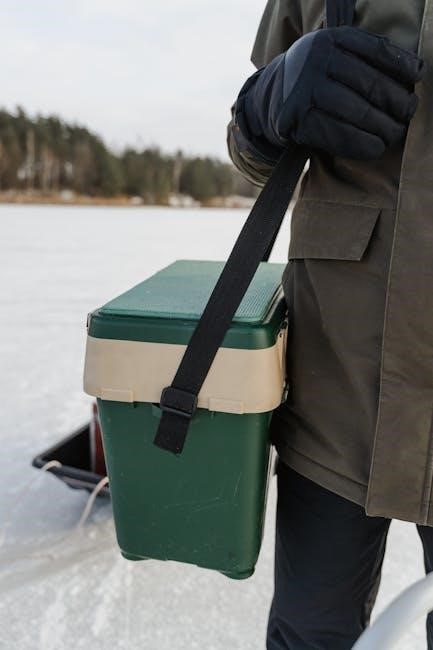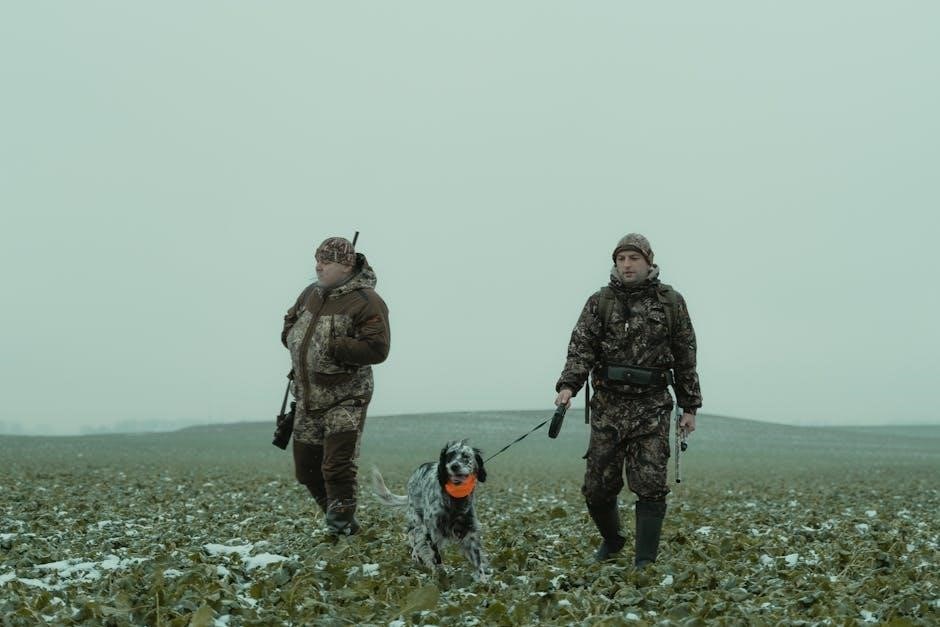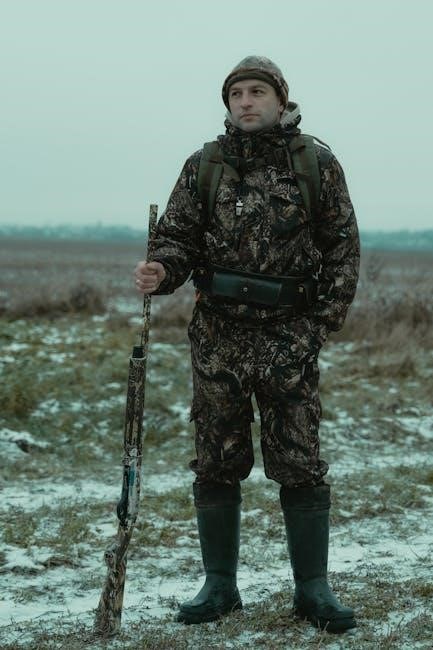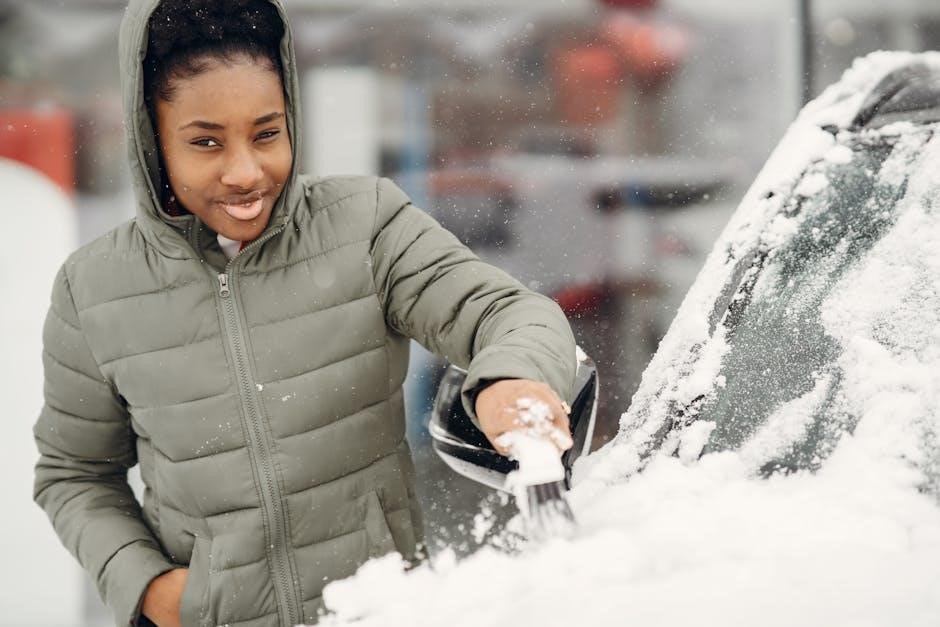Winter preparedness is crucial for safety and comfort during cold months. It helps mitigate risks like power outages‚ icy roads‚ and disruptions in essential services.
1.1 Importance of Winter Preparedness
Winter preparedness is essential to ensure safety and comfort during extreme cold weather. It helps prevent risks like hypothermia‚ frostbite‚ and power outages‚ which can be life-threatening. Preparing ahead allows families to respond effectively to winter storms‚ icy roads‚ and disruptions in essential services. A well-planned checklist ensures access to food‚ water‚ heating‚ and medical supplies‚ reducing the likelihood of emergencies. Additionally‚ preparedness minimizes economic losses from property damage and enhances community resilience. By staying informed and taking proactive steps‚ individuals can protect themselves‚ their loved ones‚ and their homes from winter’s harsh conditions. Preparation also provides peace of mind‚ knowing you’re ready to face whatever winter brings.
1.2 Key Components of a Winter Preparedness Checklist

A comprehensive winter preparedness checklist should cover essential areas to ensure safety and comfort. It typically includes emergency supplies like food‚ water‚ and medications‚ as well as tools for home maintenance‚ such as snow shovels and ice melt. Vehicle preparedness is another critical component‚ with items like flashlights‚ blankets‚ and traction aids. The checklist should also address communication needs‚ such as fully charged devices and backup power sources. Additionally‚ it should outline steps for protecting pipes‚ preventing carbon monoxide risks‚ and staying informed about weather conditions. Customization based on individual needs‚ such as pet care or medical requirements‚ ensures the checklist is practical and effective. Regular reviews and updates are vital to maintain readiness for varying winter scenarios.
Home Winter Preparedness
Home winter preparedness involves essential items like flashlights‚ batteries‚ non-perishable food‚ and water. Ensure backup heating sources‚ firewood‚ and proper insulation to maintain warmth and safety.
2.1 Essential Groceries and Non-Perishable Food
Stocking essential groceries and non-perishable food is critical for winter preparedness. Include canned goods like vegetables‚ fruits‚ and meats‚ as well as dried legumes‚ grains‚ and nuts.
- Add energy-rich snacks like granola bars‚ crackers‚ and peanut butter.
- Store at least one gallon of water per person per day for drinking and cooking.
- Don’t forget baby formula‚ pet food‚ and any necessary medications.
- Include a manual can opener and cooking supplies like oil and spices.
These items ensure you can maintain nutrition and hydration during power outages or snowstorms.
2.2 Backup Heating Sources and Firewood
A reliable backup heating source is vital during winter power outages. Consider installing a portable propane heater or a wood-burning stove as alternatives.
- Ensure proper ventilation to avoid carbon monoxide buildup.
- Store at least 3 cords of seasoned firewood‚ protected from moisture.
- Keep a supply of matches‚ kindling‚ and fire starters.
- Consider electric blankets or radiant heaters as supplementary options.
Regularly maintain heating equipment and follow safety guidelines to prevent accidents.
2.3 Insulation and Draft Prevention
Proper insulation and draft prevention are key to maintaining warmth and reducing energy costs during winter. Start by ensuring your attic‚ walls‚ and floors are well-insulated‚ especially in colder climates.
- Check for gaps or cracks in windows‚ doors‚ and fireplaces‚ and seal them with weatherstripping or caulk.
- Use draft stoppers or door sweeps to block cold air from entering through door bottoms.
- Install thermal curtains or drapes to minimize heat loss through windows.
- Consider insulating exposed pipes in unheated areas like the garage or basement;
- Disconnect and drain outdoor hoses to prevent freezing and bursting.
These steps will help keep your home warm and protect it from winter damage.

Car Winter Survival Kit
Ensure your home stays warm by insulating attics‚ walls‚ and floors. Seal gaps with weatherstripping or caulk. Use draft stoppers and thermal curtains to retain heat and block cold air.
- Inspect windows and doors for gaps.
- Install draft-proofing materials like door sweeps;
- Keep your home cozy and energy-efficient this winter.
3.1 Flashlight‚ Batteries‚ and Lighting
A reliable flashlight is essential for navigating in the dark during winter emergencies. Include extra batteries and ensure they are stored separately to avoid draining. LED flashlights are ideal due to their durability and energy efficiency. Consider adding a portable lantern for extended lighting needs. Always check battery expiration dates and keep spare bulbs for your car’s interior lights. Additionally‚ include glow sticks as a backup light source. Ensure your car’s exterior lights are clear of snow for better visibility. A signaling device‚ like flares or reflectors‚ can help others locate your vehicle if stranded. Regularly test your flashlight and lantern to ensure they are functioning properly before winter arrives.
- LED flashlight with extra batteries.
- Portable lantern or backup light sources.
- Signaling devices like flares or reflectors.
- Clear exterior lights for visibility.
3.2 Ice Scraper‚ Snow Brush‚ and Traction Aids
A sturdy ice scraper is vital for clearing windshields and windows‚ ensuring visibility during winter driving. Pair it with a snow brush to remove snow from your vehicle efficiently. Traction aids like sand‚ cat litter‚ or traction mats can provide grip on icy surfaces. Include a snow broom with soft bristles to prevent scratching your car. A de-icer spray can help melt ice quickly. Store these tools in an easily accessible location in your car. Regularly inspect your ice scraper and snow brush for wear and tear. Consider adding a small shovel for digging out your car if snowed in. These tools are essential for safe winter travel and emergency situations.
- Heavy-duty ice scraper and snow brush.
- Traction aids (sand‚ cat litter‚ or mats).
- De-icer spray and a small shovel.
- Snow broom with soft bristles.
3.3 Blankets‚ Extra Clothing‚ and Emergency Shelter
In case you become stranded‚ include warm blankets‚ extra clothing‚ and emergency shelter in your car kit. Pack thermal underwear‚ hats‚ gloves‚ and scarves to layer for warmth. Add waterproof jackets and pants‚ as well as insulated‚ waterproof boots with traction soles. A compact emergency tent or tarp with rope can provide shelter. Don’t forget a sleeping bag rated for sub-freezing temperatures and a space blanket for lightweight warmth. Hand warmers and foot warmers can offer quick heat. Store these items in a waterproof container to keep them dry. Regularly check for wear and tear‚ replacing items as needed.
- Blankets: Wool or fleece for warmth.
- Extra clothing: Thermal layers‚ hats‚ gloves‚ scarves.
- Emergency shelter: Compact tent‚ tarp‚ rope.
- Sleeping bag: Rated for cold weather.
- Hand and foot warmers: For quick heat.
- Waterproof container: To protect items.

Emergency Supplies
Stock up on essential emergency supplies‚ including water‚ non-perishable food‚ a first aid kit‚ and medications. Include flashlights‚ batteries‚ a radio‚ and a multi-tool. Add sanitation supplies‚ extra cash‚ and important documents like insurance papers and IDs. Ensure all items are easily accessible and checked regularly for expiration dates.
- Water: At least 1 gallon per person per day.
- Non-perishable food: Include high-energy snacks.
- First aid kit: Fully stocked with bandages‚ antiseptics.
- Medications: Prescription meds and pain relievers.
- Flashlight and radio: Battery-powered or hand-crank.
- Multi-tool: For various tasks.
- Sanitation supplies: Toilet paper‚ hand sanitizer.
- Important documents: Copies in waterproof containers.
- Extra cash: Small bills for emergencies.
4.1 Water and Hydration Needs
Ensure a steady supply of clean water for drinking‚ cooking‚ and hygiene during winter. Store at least one gallon per person per day for at least three days‚ plus additional for pets. Use food-grade containers‚ label them‚ and keep them in a cool‚ dark place. Rotate water every six months to maintain freshness. Consider water purification tablets or filters as a backup. In case of freezing‚ insulate pipes and know how to shut off valves. Have a plan to melt snow or ice for water if needed. Stay hydrated to avoid dehydration‚ especially in cold conditions. Don’t forget to account for pets’ water needs. Proper water storage is crucial for winter emergencies to ensure health and safety.
4.2 First Aid Kit and Medications
A well-stocked first aid kit is essential for winter preparedness. Include bandages‚ antiseptic wipes‚ gloves‚ a thermometer‚ and pain relievers. Add cold-specific items like hand and foot warmers for preventing frostbite. Ensure a supply of prescription medications‚ with a list of dosages and refill instructions. Store medications in a dry‚ secure location to avoid damage. Rotate supplies every six months to prevent expiration. Consider adding a first aid manual for guidance. Don’t forget to include personal protective equipment like masks and gloves. Ensure all household members know where the kit is located. Regularly check expiration dates and restock as needed. A prepared first aid kit can help manage minor injuries and prevent more serious issues during winter emergencies.
4.3 Cell Phone Chargers and Backup Power
A reliable source of power is crucial during winter emergencies. Include a portable cell phone charger‚ such as a lithium-ion battery pack with at least 10‚000 mAh capacity‚ to keep devices charged. A car charger is another essential for charging on the go. Consider purchasing a backup power source like a portable generator or solar charger for extended outages. Store extra power banks and ensure they are fully charged before winter. Invest in a surge protector to safeguard devices from power spikes. Keep a supply of extra charging cables and adapters. Finally‚ test backup power systems before winter to ensure they function properly. A well-prepared power supply can help maintain communication and safety during winter storms.
Safety Tips for Extreme Cold
Dress in layered‚ breathable clothing‚ stay dry‚ and limit exposure. Monitor weather forecasts and avoid travel during severe cold snaps. Keep emergency supplies accessible and ensure proper ventilation to prevent carbon monoxide poisoning. Check heating systems for safety and efficiency. Stay informed about frostbite and hypothermia symptoms. Plan for alternative heating sources and always prioritize indoor safety during extreme cold conditions.
5.1 Preventing Frozen Pipes

Preventing frozen pipes is crucial to avoid costly damage and water shortages. Insulate exposed pipes in unheated areas like garages‚ basements‚ and crawl spaces. Seal drafts near pipes‚ and let cold water drip from faucets served by exposed pipes. Know the location of your shut-off valve to turn off water quickly if pipes freeze. Disconnect and drain hoses from outdoor faucets. Keep cabinet doors open to allow warm air to circulate around plumbing. Consider installing freeze-proof faucets or frost-proof spigots in vulnerable areas. Keep your home warm‚ especially during extreme cold snaps‚ and monitor pipes in at-risk locations. Taking these steps can help protect your plumbing system from freezing temperatures.
5.2 Avoiding Carbon Monoxide Poisoning

Carbon monoxide poisoning is a silent winter hazard due to increased use of heating systems and generators. Ensure all fuel-burning appliances‚ like furnaces and water heaters‚ are properly maintained and inspected annually by professionals. Never use portable generators‚ grills‚ or propane heaters indoors‚ as they emit deadly carbon monoxide. Keep flues and chimneys clear of debris to ensure proper ventilation. Install carbon monoxide detectors on every level of your home and near sleeping areas. Test detectors monthly and replace batteries annually. Recognize symptoms like headache‚ dizziness‚ and nausea‚ which indicate exposure. If suspected‚ evacuate immediately‚ seek fresh air‚ and call emergency services. Prevention is key to staying safe during colder months.
5;3 Recognizing Hypothermia and Frostbite
Recognizing hypothermia and frostbite is crucial for winter safety. Hypothermia occurs when body temperature drops below 95°F‚ causing shivering‚ confusion‚ drowsiness‚ and slow breathing. Severe cases may lead to unconsciousness. Frostbite happens when skin and tissues freeze‚ causing numbness‚ pale skin‚ and a hard or waxy texture. Symptoms include tingling‚ stinging‚ or burning sensations. Immediate action is essential: move individuals to a warm place‚ remove wet clothing‚ and use blankets to gradually warm them. For frostbite‚ soak affected areas in warm water (not hot) and avoid rubbing. Seek medical help if symptoms persist or worsen. Prevent these conditions by dressing in layers‚ staying dry‚ and limiting exposure to extreme cold. Early recognition and proper care can prevent severe health complications during winter.

Special Considerations
Ensure winter preparedness considers unique needs‚ such as disabilities‚ pet safety‚ and rural challenges‚ to create a tailored and inclusive plan for all individuals.
6.1 Preparedness for People with Disabilities
Winter preparedness for individuals with disabilities requires a personalized approach to ensure safety and accessibility. Create a tailored emergency plan that addresses specific needs‚ such as medical equipment‚ mobility aids‚ or communication devices. Ensure backup power sources for essential devices like wheelchairs or oxygen tanks. Stock up on extra assistive devices‚ batteries‚ and medication. Clear paths of snow and ice to maintain accessibility‚ and have a reliable transportation plan in case of emergencies. Consider hiring help for shoveling or other tasks if needed. Stay informed about weather alerts and have a communication plan in place. Regularly review and update the plan to adapt to changing needs or conditions. Preparation is key to ensuring independence and safety during winter.
6.2 Winter Safety for Pets
Ensuring winter safety for pets is crucial to protect them from harsh conditions. Provide extra food and water‚ as cold weather increases energy needs. Keep pets indoors to avoid hypothermia and frostbite‚ especially for short-haired breeds. Create a warm shelter with bedding and ensure access to a dry‚ draft-free space. Avoid prolonged exposure to snow and ice‚ which can harm paws. Use pet-safe ice melts and consider booties for outdoor walks. Keep antifreeze and toxic substances out of reach. Monitor for signs of distress‚ such as shivering or lethargy. Store emergency supplies like food‚ medication‚ and a pet first aid kit. Regular grooming helps prevent matting and skin issues. Stay vigilant about their behavior and health to ensure their safety throughout the winter season.
6.3 Rural Area Winter Preparedness
Rural areas face unique winter challenges‚ such as power outages and limited access to supplies; Stock up on fuel for generators and vehicles‚ and ensure a reliable backup power source. Store extra food‚ water‚ and medications‚ as delivery services may be delayed. Consider alternative heating sources‚ like wood stoves‚ and maintain a sufficient supply of firewood. Clear snow removal equipment‚ such as snow blowers and shovels‚ and ensure they are in good working condition. Keep a two-way radio or satellite phone for communication in case of no cell service. Plan escape routes in case of extreme weather and have a backup plan for water if you rely on a well. Prepare for potential isolation by having a well-stocked emergency kit tailored to your rural needs.

Creating a Winter Preparedness Checklist
Creating a winter preparedness checklist involves organizing emergency supplies‚ reviewing seasonal needs‚ and ensuring all household members understand the plan; Regular updates ensure readiness.

7.1 Downloading and Printing the Checklist
Downloading and printing a winter preparedness checklist ensures you have a physical copy for easy reference during emergencies. Look for a reliable PDF from trusted sources like emergency management websites or government portals. Once downloaded‚ print the checklist on durable paper or laminate it for longevity. Review each item to ensure clarity and relevance to your specific needs. Store copies in multiple locations‚ such as your home‚ vehicle‚ and emergency kit. This step ensures accessibility and helps you stay organized. Regularly update the checklist to reflect changes in your household or environment. A printed version is indispensable during power outages or internet disruptions.
7.2 Customizing the Checklist for Your Needs
Customizing your winter preparedness checklist ensures it addresses your unique circumstances. Start by assessing your household’s specific needs‚ such as the number of people‚ pets‚ or medical requirements. Add personal items like essential medications‚ emergency contact lists‚ and tailored supplies for infants or elderly family members. Consider your location—urban‚ suburban‚ or rural—and adjust accordingly‚ such as adding snow removal tools for rural areas. Review and modify the checklist annually to account for changes in your household or climate. This personalization ensures the checklist remains relevant and effective‚ helping you stay prepared for winter challenges specific to your situation. Regular updates keep the checklist aligned with your evolving needs‚ enhancing its practicality and usefulness during emergencies.
Staying Informed and Updated
Stay informed about weather forecasts‚ emergency alerts‚ and updates to ensure your winter preparedness checklist remains effective. Regularly check reliable sources like weather apps and emergency management websites.
8.1 Emergency Alerts and Notifications
Signing up for emergency alerts and notifications is crucial for winter preparedness. Many governments and weather services offer systems like Emergency Alert Systems (EAS) or Wireless Emergency Alerts (WEAs) to notify residents of severe weather‚ power outages‚ or other hazards. Enable these notifications on your phone and ensure your family members are also subscribed. Additionally‚ download reliable weather apps that provide real-time updates and storm tracking. Stay tuned to local news and radio broadcasts‚ especially during extreme cold snaps or blizzards. Always keep devices charged and consider purchasing a battery-powered radio for backup. Timely alerts can help you take immediate action‚ such as evacuating or securing your home‚ ensuring safety during winter emergencies.
8.2 Following Weather Forecasts
Monitoring weather forecasts is essential for winter preparedness. Check reliable sources like the National Weather Service or local meteorologists regularly‚ especially during colder months. Stay informed about upcoming storms‚ temperature drops‚ and wind chill advisories. Download weather apps or visit trusted websites to track conditions in real-time. Sign up for alerts from meteorologists or local authorities to receive critical updates. Understanding the forecast helps you prepare for potential disruptions‚ such as power outages or icy roads. Plan ahead for travel‚ stock up on supplies‚ and ensure your home is ready for extreme conditions. Always verify information from multiple sources to ensure accuracy. Timely weather updates are key to staying safe and proactive during winter.

A well-prepared winter checklist ensures safety‚ comfort‚ and resilience. Prioritize emergency supplies‚ home safety‚ and stay informed. Regularly review and update your checklist to stay prepared.
9.1 Final Tips for Staying Safe
Staying safe during winter requires proactive measures and awareness. Always keep your winter preparedness checklist updated and easily accessible. Ensure all household members understand the plan. Stay informed about weather conditions and emergency alerts. Avoid unnecessary travel during severe storms and keep emergency contacts handy. Check on vulnerable neighbors‚ especially the elderly and those with disabilities. Maintain backup power sources and fully charged devices. Store essential supplies in reachable locations. Practice safe heating to prevent fires and carbon monoxide risks. Learn to recognize signs of hypothermia and frostbite. Finally‚ review and update your checklist regularly to adapt to changing needs and conditions.
9.2 The Importance of Continuous Preparedness
Continuous preparedness is crucial for staying safe during winter. Winter conditions can change rapidly‚ and being proactive ensures you’re ready for unexpected situations. Regularly update your winter preparedness checklist to reflect changing needs‚ such as new household members or evolving weather patterns. Practice drills with your family to ensure everyone knows the plan; Stay vigilant by monitoring weather forecasts and updating emergency supplies. Continuous preparedness also involves learning new skills‚ like basic first aid or ice safety. By maintaining a proactive mindset‚ you can reduce risks and ensure your household remains resilient throughout the winter season. Preparation is not a one-time task but an ongoing effort to stay safe and secure.